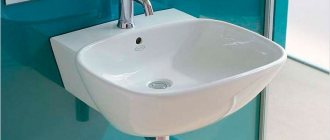The work triangle is a visual connection between the area from the stove to the sink and refrigerator. This zone is usually shaped like a triangle.
Depending on the placement of the sink area, stove and refrigerator, these kitchen options are distinguished.
Corner
This option is very loved by many designers. This solution looks great in a rectangular or square kitchen. The working triangle can be L- or L-shaped. It all depends on the selected headset.
Such an arrangement of furniture elements requires installing a sink in a free corner, and there should be functional countertops on both sides of it. A cooking panel is installed along one of the walls from the sink, and a refrigerator is placed along the other. This way, all kitchen utensils will be located in hanging cabinets.
Topic details
Optimal distances
There are certain standards by which kitchens are created. Firstly, there must be a working surface between the main zones. Secondly, what is important is the distance between the vertices of the triangle, and the size of the kitchen space itself will be of no small importance.
Please note that the ideal model is an isosceles triangle with equal sides. But, as a rule, to complete the kitchen layout with such a working
triangle is quite difficult. Modern kitchens are rarely less than 10 m2. The trend to connect the living room and kitchen has also become common, resulting in more space.
Designers strongly recommend maximizing the length of the work surface between the stove and sink because they are used most often. The maximum distance between zones is 2 human steps. If in numbers, then this is a minimum of 1.2 meters and a maximum of 2.7 meters. About 60% of the total time spent in the kitchen is spent washing dishes, so this top should be placed in the most convenient place.
Below we list the main values that are important to adhere to when placing functional areas:
- From 1 to 2 meters – the distance between the sink and the refrigerator.
- From 1.3 to 1.8 meters - between the sink and the stove.
- From 3 to 4 meters - between the tops of the far corners.
- The area of the working triangle should be from 5 to 7 square meters.
Next, it’s worth considering what types of layouts exist.
Types of Kitchen Layouts
How to determine the working triangle, and how to correctly place the vertices and maintain the required distance if the space has a rather complex layout?
Experts were able to identify several options for planning solutions for the kitchen space:
That type of layout when the kitchen set is located in a row. The working triangle is expanded here, and you can move along one line. The stove, refrigerator and sinks will be located sequentially one after another. From an ergonomic point of view, it is best to place the sink in the center, between the refrigerator and the stove. This will simplify access to all products. Most often, the single-row layout option can be found in narrow or small kitchens.
Linear.- Corner. That type of layout when the kitchen space is divided into two zones at once - dining and working. One side will be located along the wall, and the second will go perpendicular to it. It turns out to be a truly “triangular” kitchen. To correctly place the vertices of a triangle, you will need to follow several rules. The place for the sink should be in the corner; it is best to install small pieces of the countertop on the left and right sides. There will be a stove along one wall from the sink, and the refrigerator will be next to the second. With this arrangement, it will be most convenient to store kitchen utensils in wall cabinets above the sink.
- U-shape. This is a layout where there are three rows of furniture. It will be convenient to place the sink in the middle row, along with the work surface. The remaining functional areas should be placed on parallel sides, and storage space can also be made there. An important point will be lighting. There should be a lot of natural light, and you can often see options with a sink near the window. The layout is perfect for a spacious room, and the central part of the set should be installed against a wall 2 to 4 meters in length.
- Parallel is a layout in which there are two rows of furniture. In such a kitchen it will be convenient to divide the triangle into both sides. The refrigerator and sink can be placed on one side, and the stove on the opposite. The layout is perfect for walk-through and wide kitchens, and if the room is spacious enough, then on one side you can make storage systems for small household appliances. The disadvantage of such a kitchen is the difficulty in choosing a place for the dining area.
- Ostrovnaya. The layout of a working triangle in a kitchen with an island implies the presence of an additional block in the center of the room. This is the dream of many housewives, because it is convenient to cook in such a kitchen. The island can become one of the full-fledged vertices of the triangle. You can place a sink, a stove, or just a work surface on it. The remaining zones must be located in the headset. The cabinet will make it possible to make everything ergonomic, and keep in mind that the kitchen area should be at least 20 m2, because the island will greatly visually reduce the space.
- Semicircular. This is a layout where an island with an unusual shape is installed. The same principle will work here as in an island kitchen - one zone on the island, and the other two on the set. The differences are only in one part of the headset, because it will be placed in an arc. The layout option will fit perfectly into a long and very spacious room.
You should definitely take these recommendations into account when arranging your kitchen. The ergonomics of the space will directly depend on how the elements of the kitchen set are located.
How to combine aesthetics and functionality
Sometimes it is not possible to follow this rule. This is explained by the inconvenient location of communications and the impossibility of transferring them. It also happens that redevelopment is required. For the sake of convenience, apartment owners often move the kitchen or even individual areas. Remember that such actions must be coordinated with housing services. The main thing is that everything is convenient for you. This is an active zone, and it should be easy to move around, and the housewife herself should not feel like a marathon runner when cooking.
Please note that the transition lines from the vertices to each other must be free. You should not place chairs, trash cans, bar counters, etc. in the triangle area. Such attributes will create obstacles and complicate access to all functional areas.
Proper design will imply the presence of a triangle. Especially if you cook often. A beautiful interior will primarily imply functionality, and only then the beauty of design. You can combine convenience and aesthetics with the help of design techniques and imagination. It also turns out that the kitchen layout does not give the required result, and this is often observed with large areas. In this case, give preference to stylish design, especially if you have two kitchens - for cooking and eating.
When is a working triangle not needed?
Although the concept of a work triangle is based on a very simple logic - we take food out of the refrigerator, wash it and cook it on the stove. If you have a Khrushchev building or just a small apartment, then you can forget about this rule. The fact is that in small kitchen spaces there is so little space that even if you wanted to follow all the rules of the triangle, you simply will not be able to.” It is for this reason that it is impossible to maintain a distance of 1.3 meters or more between the three peaks. Therefore, you should rely on your sense of logic, your ideas about convenience and take into account the features of the room.
Small kitchens are a constant compromise - the developers and scientists of this very triangle agreed that comfortable work requires at least 5 m2, and this does not include the concept of a dining area, although we also eat in the kitchen.
For this reason, we suggest thinking about the process:
- Decide where to put the refrigerator. Yes, it may not always successfully fit into your “baby”, and you may have to move it to the hallway, or combine the kitchen and living room.
- Leave at least 0.3 meters between the stove (hob) and the sink so that there is room for cutting food.
- Pay attention to 2 in 1 appliances: oven and microwave, oven and dishwasher. Yes, such solutions will be many times more expensive, but they will help save a lot of space.
- Consider miniature appliances or replacing one appliance with another. For example, choose a 2-burner device instead of a 4-burner hob. You can also abandon the oven in favor of a convection microwave.
- Place only sliding/folding tables.
These simple rules will help you decide on the arrangement of furniture and household appliances in your small kitchen.
Island
A kitchen of this type has become the dream of most housewives. She looks very stylish. This environment is convenient for preparing dishes. This layout is suitable for rooms with an area of at least 20 m2, since the island visually narrows the room.
Experts note that the island becomes one of the vertices of the working triangle if a sink or stove is placed on it. In this case, the refrigerator and the second element of the triangle are placed in the set.
If an island is used instead of a dining group, the arrangement of the triangle is equivalent to a linear or angular layout.
Linear layout
A linear kitchen gives you freedom of decision: appliances can easily be placed along the wall. To obtain the most ergonomic option, the sink should be placed in the central part of the unit. The kitchen stove (hob) and refrigerator are installed at the edges. If space allows, the microwave can be placed in a separate column.
Please note: it is best to place the dishwasher or dryer directly next to the sink. You shouldn’t skimp on the space for cooking (working area) - all the missing household appliances can easily fit here.
Designer recommendations
When two housewives are cooking in the kitchen, you should be very careful when planning the work triangle. Their trajectory of movement will intersect if the scheme is thought out incorrectly. This will not only be uncomfortable, but also dangerous, given that in the kitchen you have to deal with boiling water and hot oil.
An isosceles triangle is considered ideal, but it is difficult to implement such an idea in a small kitchen. Here it would be more appropriate to arrange the furniture in one line.
An island kitchen requires as much free space as possible. For comfortable use of space around the island there must be a place with a radius of at least 1.2 meters.
It is more convenient to place the cooking and washing areas nearby so that there is no need to cross the aisle with dangerous hot pots and a kettle. When the island is large, it is worth installing a sink with a stove. It can also be used to store kitchen utensils or to organize seating.
What kind of kitchen do you have?
Triangle rule for the kitchen
Working in the kitchen is already something akin to a sport, because walking short distances is replaced by stops, bending in different directions and other body movements. People began to think about optimizing movements back in the last century. Triangle technology was invented back in 1920 in Germany. To keep home life orderly, German scientists decided to conduct an independent study. For some time, they observed the movements of women in the kitchen while cooking.
The distance traveled from one object to another was taken into account, as well as the time spent moving. Through the study, scientists were able to produce a formula for arranging the main zones in the kitchen - food storage, food preparation. This is how the same triangle appeared, the rule of which is still used today. This helps optimize movements when cooking.
Interestingly, German scientists were not the first to think about this. American-born architect Frank Wright noted that the arrangement of a kitchen should be done taking into account the height and proportions of a person’s figure.
The vertices of the figure are the sink, refrigerator and stove. These are the three main elements of work surfaces. The logic is simple - you took the food out of the refrigerator, turned to the sink, washed it, and then put it in the frying pan.
Let's take a closer look at the main areas of the kitchen space:
- The refrigerator is the largest appliance. It is highly undesirable to place it outside the kitchen area, because this can lead to the work surface being torn into pieces, and this is extremely inconvenient. It is important to consider the placement of the refrigerator. The door should open without problems and not block all the free space. Take a closer look at models that are equipped with removable doors. This device will definitely fit into any type of kitchen.
- The sink is the central element. Washing food and dishes takes a lot of time, and therefore it is also called the center of activity.
- The stove (hob) is the most dangerous appliance. The stove should be placed away from potholders, curtains and towels. Experts advise installing equipment near the eating area. In this case, it is worth ensuring that there is a free passage.
Kitchen ergonomics with corner furniture arrangement
When a kitchen set is installed along two adjacent walls, it is both rational and aesthetically pleasing at the same time. Compared to other layout options, the ergonomics of a corner kitchen are considered optimal. Here it is easiest to follow the rule of the working triangle: its vertices are located on two mutually perpendicular lines, which is very convenient.
Ergonomic corner kitchen
The corner arrangement of the furniture set is equally suitable for a kitchen with a large or small area.
There is one secret here. It is more correct to use corner sections with a beveled facade - they are much more spacious due to the additional volume and look elegant. In this case, the housewife needs to determine the depth of the module in advance, establishing at what value she can easily reach the joint of the walls and carry out cleaning.
Comfortable kitchen with sloping facade
Most often, the corner is given over to the sink. In spacious kitchens, a stove or cabinet with a hob is placed at an angle. You can also use a tall pencil case to solve the problem of storing food, dishes and household appliances.
Kitchen with a U-shaped layout: proper ergonomics
The ergonomics of a U-shaped kitchen differs little from the previous version, although it has its own characteristics. Arranging furniture along three adjacent walls does not contradict the conditions of the “working triangle”. However, this technique can only be used in spacious kitchens, so as not to impede movement. The dining group is made either near the window, using a work surface under the tabletop, or taken out separately to the dining area.
The distance between the extreme points of the floor cabinets located opposite each other should be 1.2 - 1.5 m. A passage that is too narrow or too wide between the kitchen modules will interfere with the productive activity of the housewife in the kitchen.
Sometimes the sink, refrigerator and stove are placed linearly on one side, and the other is completely “given over” to the dining area. The ergonomics of a U-shaped kitchen should be carefully considered. Therefore, it is advisable to involve a designer or do the calculations yourself, taking into account our tips on zoning space and arranging furniture in the kitchen.
Conveniently planned small U-shaped kitchen without a refrigerator.
Layout of a large kitchen - use the space rationally
In a spacious kitchen, creating an ergonomic space is sometimes more difficult than in a small one.
Ergonomics of a large kitchen, photo
It is important that the stove, refrigerator and sink, which are part of the working triangle, are located compactly and the housewife does not have to travel long distances while cooking. The remaining area accommodates a dining group and additional storage systems.
For a large kitchen, the most ergonomic is the U-shaped layout, combining the unit with an “island” or corner options with a bar counter.
Large P-kitchen: creating comfort
We organize storage space and arrange household appliances
In order not to “get lost” in a large space, it is necessary to properly organize storage areas. Again, tips on kitchen ergonomics will help with this.
Heavy frying pans and pots, as well as vegetables and large packages of food are placed in the drawers of the lower tier.
Dishes that are frequently used during cooking, as well as small household appliances, should be stored closer to the work surface. It is recommended to install several sockets in this area so that you can turn on your kitchen “helpers” without interference.
On the upper shelves of wall cabinets, formal table textiles, rarely used dishes and containers with dry products are placed.
It is better to place the microwave next to the refrigerator or above it, built into a single pencil case. Having taken out the food, you can immediately defrost it.
Adviсe
After updating the kitchen interior, they move on to arranging furniture and electrical appliances. Everything is arranged in a hurry, tired during repairs. Trivial thoughts about where to hang a closet or place a dining table are left to those who do repairs not with their own hands, but with the help of qualified craftsmen. This approach will come back to haunt you in the future with the lack of efficiency in movement and the unavailability of necessary items when preparing food. If you spend a little more time and beat the work zones first, this will not happen. The work triangle in the kitchen is arranged correctly by taking the following tips into account.
- The gas/induction/electric stove and oven are placed near the sink and not far from the table. Otherwise, you may get burned when carrying a hot pan to the sink to drain the water.
- The ideal place for washing is near the refrigerator and gas stove.
- A tall cabinet with shelves is placed next to the refrigerator (they don’t carry bags of what they bought at the supermarket from corner to corner).
There's a place for everything
During one day in a standard kitchen, there are approximately 100 movements between activity areas, approximately 50 different activities, nearly 30 different uses of various appliances, and 80 opening and closing of doors and drawers.
If a little effort, time, or movement is saved with each action, the resulting savings will be enormous. To get the contents out faster and easier, you should place them in the appropriate areas of the kitchen.
Three main vertical zones can be distinguished:
- low (from floor to waist)
- medium (from the waist to the distance of the raised arm)
- and high (above the level of the raised hand).
In the low and high zones you should place items that you rarely use, reserving the middle zone for the most necessary things.
It also matters how exactly the space is organized in each of the vertical zones: whether it will be drawers, shelves or something specialized.
Doors in a low zone are ergonomically very inconvenient; you have to search for the necessary items in the cabinets for a long time, since all the contents are not visible at once. In drawers, on the other hand, everything is clearly visible and optimally accessible.
In the photo: Old Line Sapore veneto kitchen.
You can read more about the rational use of kitchen space in the article “Principles of proper ergonomics.”











